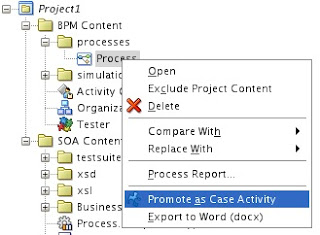Introduction
Oracle announced its new BPM 11.1.1.7 produkt.I found it interested that also (Adaptive) Case Management was added and i was curious what the difference is between the Oracle and Cordys approach w.r.t. Case Management. In this Blog item i will discuss some of the the differences and resemblance.
Adapative Case Management
Both Cordys and Oracle agree on the fact that there are processes that are not defined ahead and a knowledge worker can define the path as the case progresses. So that's good news.
Also both in Oracle and Cordys the case management and normal BPMN processes can be mixed.
Oracle
Users can define a Case and associate it with a set of Case Activities. In addition to Case activities, the Case definition consists of case data, case documents, case rules, case events, case milestones, case stakeholders, and case outcomes. The progression of a case is indicated via case milestones. A case milestone signifies completion of a stage in a case and is useful as it provides high-level snapshots for management to validate the progress of a case. A case is said to be complete when a case outcome is reached.
Users can define a Case and associate it with a set of Case Activities. In addition to Case activities, the Case definition consists of case data, case documents, case rules, case events, case milestones, case stakeholders, and case outcomes. The progression of a case is indicated via case milestones. A case milestone signifies completion of a stage in a case and is useful as it provides high-level snapshots for management to validate the progress of a case. A case is said to be complete when a case outcome is reached.
The case activities could be BPMN based processes or human workflow tasks or notifications or could be
even an automated system step. These activities could be mandatory or optional and become available
to the case worker at various points as the case progresses. The activation of a case activity can be
manual or automatic based on case rules or case events or reaching of a case milestone. In addition to
pre-defined case activities, the platform also supports creation of case activities by a case worker.
even an automated system step. These activities could be mandatory or optional and become available
to the case worker at various points as the case progresses. The activation of a case activity can be
manual or automatic based on case rules or case events or reaching of a case milestone. In addition to
pre-defined case activities, the platform also supports creation of case activities by a case worker.
After creation of a Case Management Component in Oracle BPM two components of the implementation are created: a Case object and a Case related rules set.
The true engine behind the case management is Oracle's Rule Engine. Their you can define what should be happen when an event occurs.
(Asynchronous) processes can be used within Cases and the rule engine when promoted to case activity.
Cordys
Cordys takes a more modelling approach. It uses Functional States to model the possible states within the case (i.s.o. Milestones). The activities can also be human tasks, processes or automated steps. The case model is visualized.
The following activity within the case can be defined using Automatic, Free or Intermediate. The Free follow-up activities can be selected by the Knowledge worker within that particular functional state. Automatic activities are executed automatically when the previous activity is finished. Intermediate activity is an activity that can be selected by the knowledge worker as a kind of side step.
Events or when activities are completed within a functional state are used to define transitions between states.
Cases and BPMN processes can be mixed within Cordys as well.
Documents
Oracle
Oracle integrates with its Oracle Web Center Content product component. Oracle BPM 11.1.1.7 also supports integration with 3rd party content management systems via CMIS (Content Management Interoperability Services) interfaces.
Cordys
Cordys integrates default with JackRabbit. Also custom CMS integration is possible when adhered to JSR 170 compliant interface.Conclusions
Oracle an entity modeler to define the case data.
Cordys uses an XML editor to define the case data.
Oracle uses a rule engine table to define the case using events, activities and milestones.
Cordys takes the modeling approach using functional states, events and activities.
Oracle has good integration with its document store system.
Cordys takes the open source Jack Rabbit as its default document store system.
Of course both products have a lot of more features, but this gives you already some overview.
More can be found:
Cordys: http://www.cordys.com/






Its really nice.But I required few more things related cordys....BPM,How to make the BPM in cordys in optimal way.If you would make some technical descriptions it would helpful for us...Wat abt ur certification?
BeantwoordenVerwijderenHello "Hi",
BeantwoordenVerwijderenJust back from vacation, but what would you like to see about technical descriptions? What would you like to know about Cordys?
Regards, Roger
what is the future of cordys BPM Tool ?
BeantwoordenVerwijderenHello Bineesh,
VerwijderenAs you may know, Cordys has been incorporated by OpenText. The Cordys produkt will be integrated within OpenText Process Suite. I have posted another blog item about this: http://rogervdkimmenade.blogspot.nl/2013/11/opentext-process-suite-105-platform.html
The core of the OpenText BPM solution will be Cordys. The UI will be replaced by a unified UI (HTML5 i.s.o. XForms).
Hope this answers your question?
Regards, Roger